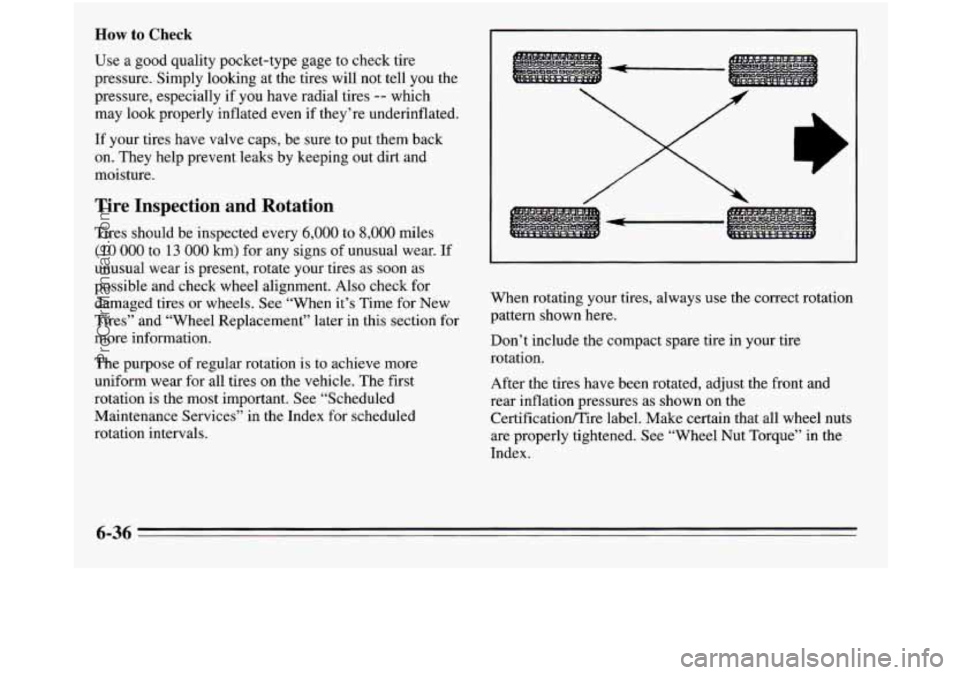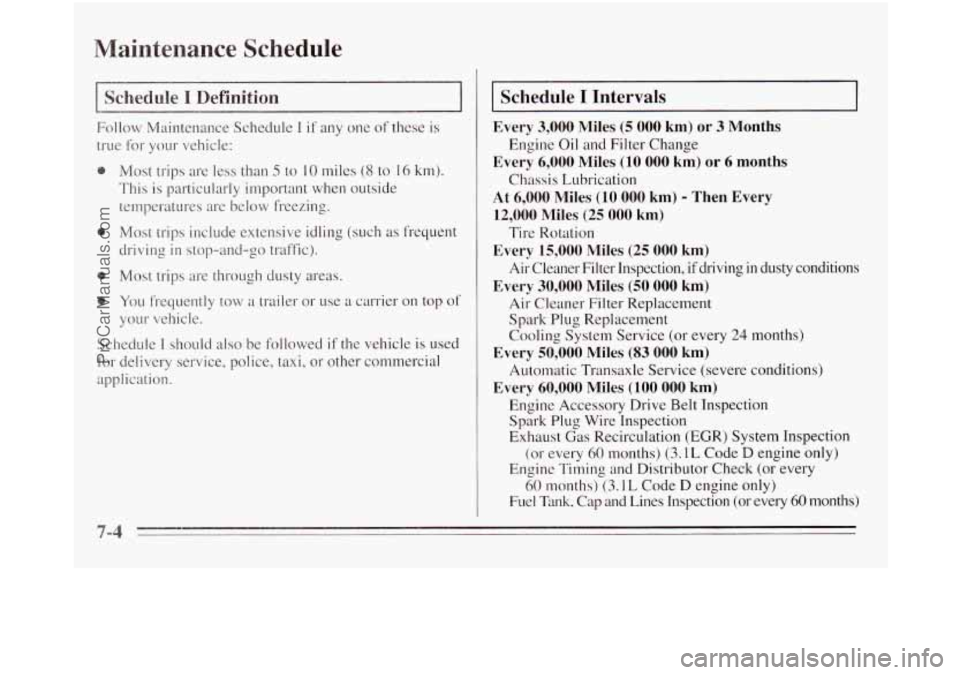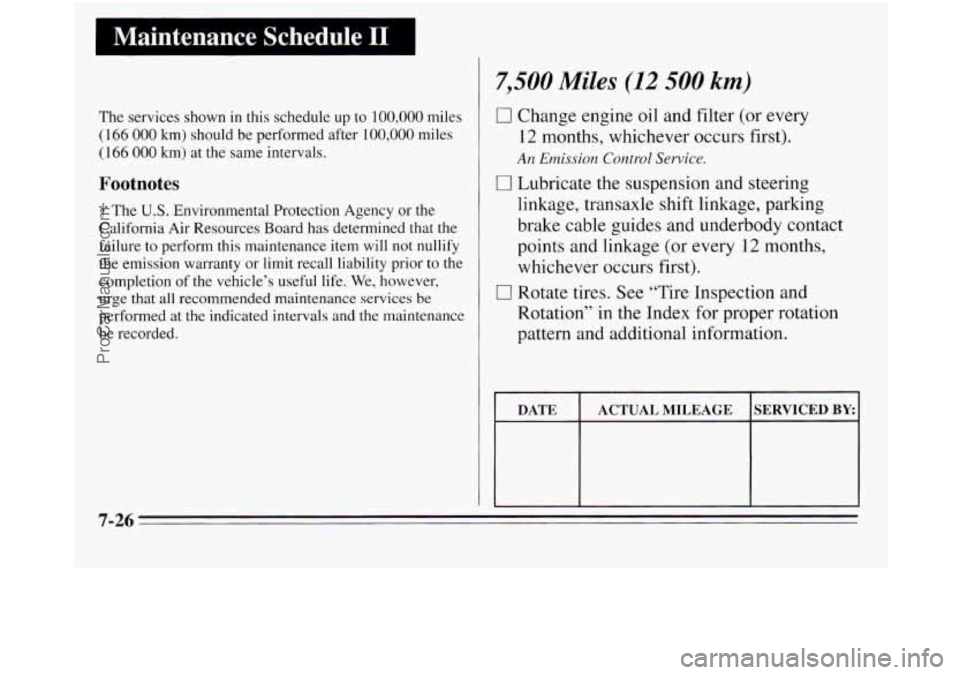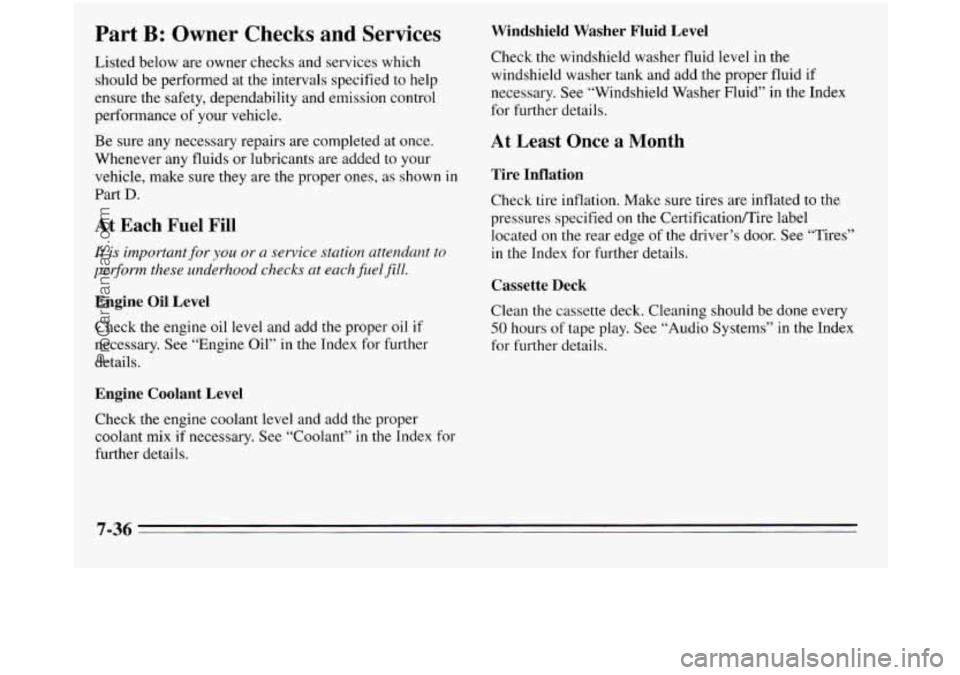Page 296 of 390

How to Check
Use a good quality pocket-type gage to check tire
pressure. Simply looking at the tires will not tell you the
pressure, especially if you have radial tires
-- which
may look properly inflated even if they’re underinflated.
If your tires have valve caps, be sure to put them back
on. They help prevent leaks by keeping out dirt and
moisture.
Tire Inspection and Rotation
Tires should be inspected every 6,000 to 8,000 miles
(1 0 000 to 13 000 km) for any signs of unusual wear. If
unusual wear is present, rotate your tires as soon as
possible and check wheel alignment. Also check for
damaged tires or wheels. See “When it’s Time for New
Tires” and “Wheel Replacement” later in this section for
more information.
The purpose
of regular rotation is to achieve more
uniform wear for all tires on the vehicle. The first
rotation is the most important. See “Scheduled
Maintenance Services” in the Index for scheduled
rotation intervals. When
rotating your tires, always use the correct rotation
pattern shown here.
Don’t include the compact spare tire in your tire
rotation.
After the tires have been rotated, adjust the front and
rear inflation pressures as shown on
the
Certificatioflire label. Make certain that all wheel nuts
are properly tightened. See “Wheel Nut Torque” in the
Index.
6-36
ProCarManuals.com
Page 326 of 390

Maintenance Schedule
I Schedule I Definition I
Follow Maintenance Schedule I if any one of these is
true for your vehicle:
0 Most trips are less than 5 to 10 miles (8 to 16 km).
This is particularly important when outside
temperatures are below freezing.
0 Most trips include extensive idling (such as frequent
driving in stop-and-go traffic).
0 Most trips are through dusty areas.
0 You frequently tow a trailer or use a carrier on top 0.f
your vehicle.
Schedule
I should also be followed if the vehicle is used
for delivery service, police, taxi, or other commercial
application.
Schedule I Intervals
Every 3,000 Miles (5 000 km) or 3 Months
Engine Oil and Filter Change
Every 6,000 Miles (10 000 km) or 6 months
Chassis Lubrication
At 6,000 Miles (10 000 km) - Then Every
12,000 Miles (25 000 km)
Tire Rotation
Every 15,000 Miles (25 000 km)
Air Cleaner Filter Inspection, if driving in dusty conditions
Every 30,000 Miles (50 000 km)
Air Cleaner Filter Replacement
Spark Plug Replacement
Cooling System Service (or every
24 months)
Automatic Transaxle Service (severe conditions)
Engine Accessory Drive Belt Inspection
Spark
Plug Wire Inspection
Exhaust
Gas Recirculation (EGR) System Inspection
(or every
60 months) (3.1L Code D engine only)
Engine Timing and Distributor Check (or every
60 months) (3.1 L Code D engine only)
Fuel Tank, Cap and Lines Inspection
(or every 60 months)
Every 50,000 Miles (83 000 km)
Every
60,000 Miles (100 000 km)
7-4
ProCarManuals.com
Page 328 of 390
I Maintenance Schedule I I
3,000 Miles (5 000 km)
The services shown in ms. schedule up to 100,000 miles
(166 000 km) should be performed after 100,000 miles
(166 000 km) at the same intervals.
Footnotes
The U.S. Environmental Protection Agency or the
California Air Resources Board has determined that the
failure to perform this maintenance item will not nullify
the emission warranty or limit recall liability prior to the
completion of the vehicle's useful life. We, however,
urge that all recommended maintenance services be
performed at the indicated intervals and the maintenance
be recorded.
0 Change engine oil and filter (or every
3 months, whichever occurs first).
An Emission Control Service.
DATE ACTUAL MILEAGE SERVICED BY: I
7-6
ProCarManuals.com
Page 348 of 390

I Maintenance Schedule I1
7,500 Miles (12 500 km)
The services shown in this schedule up to 100,000 miles
(166 000 km) should be performed after 100,000 miles
(166 000 km) at the same intervals.
Footnotes
7 The U.S. Environmental Protection Agency or the
California Air Resources Board has determined that the
failure to perform this maintenance item will not
nullify
the emission warranty or limit recall liability prior to the
completion
of the vehicle’s useful life. We, however,
urge that all recommended maintenance services
be
performed at the indicated intervals and the maintenance
be recorded.
0 Change engine oil and filter (or every
12 months, whichever occurs first).
An Emission Control Service.
I7 Lubricate the suspension and steering
linkage, transaxle shift linkage, parking
brake cable guides and underbody contact
points and linkage (or every
12 months,
whichever occurs first).
0 Rotate tires. See “Tire Inspection and
Rotation”
in the Index for proper rotation
pattern and additional information.
I DATE I ACTUALMILEAGE ISERVICED BYI
7-26
ProCarManuals.com
Page 358 of 390

Part B: Owner Checks and Services
Listed below are owner checks and services which
should be performed at the intervals specified to help
ensure the safety, dependability and emission control
performance of your vehicle.
Be sure any necessary repairs are completed at once.
Whenever any fluids or lubricants are added
to your
vehicle, make sure they are the proper ones, as shown in
Part
D.
At Each Fuel Fill
It is important for you or a service stution attendant to
pe$orm these underhood checks at each fueljill.
Engine Oil Level
Check the engine oil level and add the proper oil if
necessary. See “Engine Oil”
in the Index for further
details.
Windshield Washer Fluid Level
Check the windshield washer fluid level in the
windshield washer tank and add the proper fluid if
necessary. See “Windshield Washer Fluid” in the Index
for further details.
At Least Once a Month
Tire Inflation
Check tire inflation. Make sure tires are inflated to the
pressures specified on the CertificatiodTire label
located on the rear edge
of the driver’s door. See “Tires”
in the Index for further details.
Cassette Deck
Clean the cassette deck. Cleaning should be done every
50 hours of tape play. See “Audio Systems” in the Index
for further details.
Engine Coolant Level
Check the engine coolant level and add the proper
coolant mix
if necessary. See “Coolant” in the Index for
further details.
7-36
ProCarManuals.com
Page 364 of 390
Part E: Maintenance Record
After the scheduled services are performed, record the
date, odometer reading and who performed the service
in the boxes provided after the maintenance interval. Any
additional information from “Owner Checks and
Services” or “Periodic Maintenance” can be added
on
the following record pages. Also, you should retain all
maintenance receipts. Your owner information portfolio
is a convenient place to store them.
Maintenance Record
7-42
ProCarManuals.com